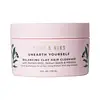What's inside
What's inside
 Key Ingredients
Key Ingredients

 Benefits
Benefits

 Concerns
Concerns

 Ingredients Side-by-side
Ingredients Side-by-side

Glycerin
HumectantSodium Cocoyl Isethionate
CleansingKaolin
AbrasiveCoconut Acid
CleansingVaccinium Corymbosum Seed
AbrasiveCetearyl Alcohol
EmollientPolylactic Acid
AbrasiveSodium Isethionate
CleansingCocos Nucifera Oil
MaskingBentonite
AbsorbentBehentrimonium Methosulfate
Tapioca Starch
Moringa Oleifera Seed Oil
EmollientSimmondsia Chinensis Seed Oil
EmollientArnica Montana Flower Extract
MaskingEclipta Prostrata Leaf Extract
Skin ConditioningHibiscus Esculentus Fruit Extract
Skin ConditioningPhyllanthus Emblica Fruit Extract
HumectantParfum
MaskingPhenoxyethanol
PreservativeCaprylyl Glycol
EmollientGlycerin, Sodium Cocoyl Isethionate, Kaolin, Coconut Acid, Vaccinium Corymbosum Seed, Cetearyl Alcohol, Polylactic Acid, Sodium Isethionate, Cocos Nucifera Oil, Bentonite, Behentrimonium Methosulfate, Tapioca Starch, Moringa Oleifera Seed Oil, Simmondsia Chinensis Seed Oil, Arnica Montana Flower Extract, Eclipta Prostrata Leaf Extract, Hibiscus Esculentus Fruit Extract, Phyllanthus Emblica Fruit Extract, Parfum, Phenoxyethanol, Caprylyl Glycol
Water
Skin ConditioningDecyl Glucoside
CleansingLauryl Glucoside
CleansingSodium Cocoyl Isethionate
CleansingGlycerin
HumectantCoco-Glucoside
CleansingAloe Barbadensis Leaf Juice Powder
Skin ConditioningDisodium Coco-Glucoside Citrate
EmulsifyingDiheptyl Succinate
EmollientGlyceryl Oleate
EmollientAmaranthus Caudatus Seed Extract
Skin ConditioningCapryloyl Glycerin/Sebacic Acid Copolymer
Skin ConditioningAllium Cepa Bulb Extract
Skin ConditioningLactobacillus Ferment
Skin ConditioningNigella Sativa Seed Extract
PerfumingPhyllanthus Emblica Fruit Extract
HumectantTrigonella Foenum-Graecum Seed Extract
PerfumingWithania Somnifera Root Extract
Skin ConditioningHydrolyzed Adansonia Digitata Seed Extract
Glyoxal
AntimicrobialCamellia Sinensis Leaf Extract
AntimicrobialYucca Schidigera Root Extract
Skin ConditioningGuar Hydroxypropyltrimonium Chloride
Skin ConditioningPhenoxyethanol
PreservativeParfum
MaskingHydroxyethylcellulose
Emulsion StabilisingGluconolactone
Skin ConditioningBenzyl Alcohol
PerfumingTocopherol
AntioxidantHydrogenated Palm Glycerides Citrate
EmollientSodium Benzoate
MaskingPotassium Sorbate
PreservativeCitric Acid
BufferingBenzyl Salicylate
PerfumingLimonene
PerfumingHydroxycitronellal
PerfumingWater, Decyl Glucoside, Lauryl Glucoside, Sodium Cocoyl Isethionate, Glycerin, Coco-Glucoside, Aloe Barbadensis Leaf Juice Powder, Disodium Coco-Glucoside Citrate, Diheptyl Succinate, Glyceryl Oleate, Amaranthus Caudatus Seed Extract, Capryloyl Glycerin/Sebacic Acid Copolymer, Allium Cepa Bulb Extract, Lactobacillus Ferment, Nigella Sativa Seed Extract, Phyllanthus Emblica Fruit Extract, Trigonella Foenum-Graecum Seed Extract, Withania Somnifera Root Extract, Hydrolyzed Adansonia Digitata Seed Extract, Glyoxal, Camellia Sinensis Leaf Extract, Yucca Schidigera Root Extract, Guar Hydroxypropyltrimonium Chloride, Phenoxyethanol, Parfum, Hydroxyethylcellulose, Gluconolactone, Benzyl Alcohol, Tocopherol, Hydrogenated Palm Glycerides Citrate, Sodium Benzoate, Potassium Sorbate, Citric Acid, Benzyl Salicylate, Limonene, Hydroxycitronellal
Ingredients Explained
These ingredients are found in both products.
Ingredients higher up in an ingredient list are typically present in a larger amount.
Glycerin is already naturally found in your skin. It helps moisturize and protect your skin.
A study from 2016 found glycerin to be more effective as a humectant than AHAs and hyaluronic acid.
As a humectant, it helps the skin stay hydrated by pulling moisture to your skin. The low molecular weight of glycerin allows it to pull moisture into the deeper layers of your skin.
Hydrated skin improves your skin barrier; Your skin barrier helps protect against irritants and bacteria.
Glycerin has also been found to have antimicrobial and antiviral properties. Due to these properties, glycerin is often used in wound and burn treatments.
In cosmetics, glycerin is usually derived from plants such as soybean or palm. However, it can also be sourced from animals, such as tallow or animal fat.
This ingredient is organic, colorless, odorless, and non-toxic.
Glycerin is the name for this ingredient in American English. British English uses Glycerol/Glycerine.
Learn more about GlycerinParfum is a catch-all term for an ingredient or more that is used to give a scent to products.
Also called "fragrance", this ingredient can be a blend of hundreds of chemicals or plant oils. This means every product with "fragrance" or "parfum" in the ingredients list is a different mixture.
For instance, Habanolide is a proprietary trade name for a specific aroma chemical. When used as a fragrance ingredient in cosmetics, most aroma chemicals fall under the broad labeling category of “FRAGRANCE” or “PARFUM” according to EU and US regulations.
The term 'parfum' or 'fragrance' is not regulated in many countries. In many cases, it is up to the brand to define this term.
For instance, many brands choose to label themselves as "fragrance-free" because they are not using synthetic fragrances. However, their products may still contain ingredients such as essential oils that are considered a fragrance by INCI standards.
One example is Calendula flower extract. Calendula is an essential oil that still imparts a scent or 'fragrance'.
Depending on the blend, the ingredients in the mixture can cause allergies and sensitivities on the skin. Some ingredients that are known EU allergens include linalool and citronellol.
Parfum can also be used to mask or cover an unpleasant scent.
The bottom line is: not all fragrances/parfum/ingredients are created equally. If you are worried about fragrances, we recommend taking a closer look at an ingredient. And of course, we always recommend speaking with a professional.
Learn more about ParfumPhenoxyethanol is a preservative that has germicide, antimicrobial, and aromatic properties. Studies show that phenoxyethanol can prevent microbial growth. By itself, it has a scent that is similar to that of a rose.
It's often used in formulations along with Caprylyl Glycol to preserve the shelf life of products.
This ingredient is also known as Indian Gooseberry. It is skin hydrating and antioxidant rich.
Sodium cocoyl isethionate is a natural ingredient from coconut oil. It is an ultra gentle cleanser that gives a nice foam without drying the skin or impacting the skin barrier.
The amount of foam created depends on the amount of sodium cocoyl isethionate used in the product.
This ingredient also helps improve the spreadability of a product.
Learn more about Sodium Cocoyl Isethionate